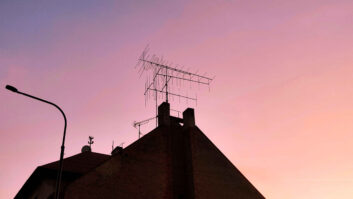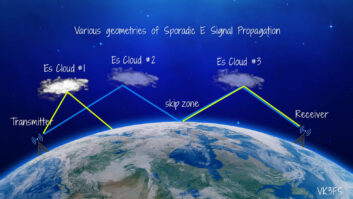Engineering consultant David Maxson, a principal with Isotrope LLC, saw Jack Roland’s submission about a mast on a pivot in our Nov. 7 column. The article reminded David of a translator in Newport, R.I.
The mast has been up for about 25 years with a Shively two-bay antenna. The coax deteriorated to the point that when its surface was wet, the VSWR jumped up. To inspect and ultimately replace the cable, and to inspect the bays, David wanted to make it a one-person operation.
His goal was to be able to tilt the mast down, without damaging the structural integrity when the mast was up. To achieve this, David mounted a short section of pipe on the mast-mount, directly beneath the mast. He then joined the short pipe to the mast using a tough Unistrut hinge.
Next, David scrounged a sturdy fiber-reinforced plastic beam to serve as a gin pole. (This nonconductive material should have little impact on the antenna pattern, if he decided to leave the rig in place.)
David then calculated the load and selected hoisting gear — including pulleys, cable and a winch — adequate to handle it. He picked up a cheap boat-trailer winch at the local discount tool store. David points out that the rig has a 2:1 mechanical advantage. This reduces the force on the winch but doubles the amount of cranking needed to move the mast up and down.
The next step was to remove the clamps from the main mast and lower it with the winch. Voilà! Easy access to the antenna and the line.
Take care to ensure that the transmission line is free to follow the lowering of the mast, without getting crimped. Just as important, remember to e-connect and ground connections and cable ties when you’re done.
***
Dr. Curtis Holsopple, K9CH, is an academic coordinator for graduate studies at Virginia State University’s Department of Mass Communications in Petersburg, Va. Curt has enjoyed learning how other Workbench readers have gotten into broadcasting.
In his case, it started with an appearance on a local kid-oriented TV show in San Francisco in 1955. Curt’s older sister appeared on the program for her birthday, and Curt (the bratty little brother) insisted on going along.
He was only four years old but he still remembers the towering studio doors, cables snaking all over the studio floor, the camera and floor director crew wearing headsets, and the very cheesy set for the show. Curt wasn’t disillusioned — he was fascinated.
A couple of years later, his dad did some radio broadcasts in Tacoma, Wash., and Curt wanted to go along. He got a full tour of the studios and control room. He saw the DJ cueing records and tapes, noticed his audio board operations, the movement of the VU meter — and heard him do a live commercial for Sunbeam bread.
Curt eventually got the little-boy wiggles, and was excused to the car to sit with Mom and listen to Dad on the car radio. That’s when he realized that he could tune away from that radio station and select a different one, even though Dad was talking through a tower that was right there in front of him. Curt wanted to know how that worked.
He got into ham radio when he was 10, then radio and TV broadcast work at 15. He soon started studying for the First Phone. That led to a 50-year career in broadcast-related work and mass media education.
I told Curt about a similar experience I had on NBC 4’s “Bozo” show, with Willard Scott as Bozo in Washington. I rushed home and built a “camera” out of a cardboard box, gluing a soup can and tuna can to a pie tin — which I would turn to select the appropriate “lens.”
Curt tells me he made a cardboard camera, too. In his case, he used a shoe box and a gift wrapping paper tube so he could actually look through his camera. His tripod? A kid-size coat tree. Curt cut a hole in the bottom of the box and stuck it on top. This permitted tilt and pan moves! But dolly and truck were more like “scrape and drag.”
Author John Bisset has spent 48 years in the broadcasting industry.









